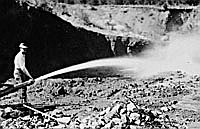- Catalog No. —
- OrHi 99302
- Date —
- 1851
- Era —
- 1846-1880 (Treaties, Civil War, and Immigration)
- Themes —
- Environment and Natural Resources, Geography and Places, Native Americans, Oregon Trail and Resettlement, Trade, Business, Industry, and the Economy
- Credits —
- Oregon Historical Society
- Regions —
- Oregon Country Oregon Trail Southwest
- Author —
- N. Scholfield
Southern Oregon & Northern California
The 1848 discovery of gold in California was a lure for many Euro Americans, including up to two-thirds of the men who had recently crossed the Oregon Trail and settled in the Willamette Valley. This map, created during the California gold rush, shows the California gold regions and “southern” Oregon. Oregon Territory originally included what are now the states of Washington and Idaho. Oregon became a state in 1859, and the Columbia River defined its northern border. Miners traveling from Oregon to California passed through the Rogue River Valley. In December 1851, several men discovered gold near present-day Jacksonville, sparking a rush of miners into the area from both the Willamette Valley and northern California. The initial method of placer mining for gold was later replaced by the use of pressurized water that removed entire hillsides. Boom towns, such as Jacksonville, Waldo, and Gold Hill, grew throughout the area to provide miners with supplies. Rogue River Valley Indians did not welcome interlopers, and they gained a reputation for attacking fur traders, explorers, and immigrants. Violence became common between the Indians and miners, culminating in the Rogue River War in 1855.
Further Reading:
Beckham, Stephen Dow. Requiem for a People. 2nd Edition. Corvallis, Oreg., 1971.
Written by Kathy Tucker, © Oregon Historical Society, 2002.
Related Historical Records
-
Gold!
In 1848, two years after Lindsay Applegate traveled through the Rogue River Valley, the discovery of gold in Sutter’s Mill, California, brought prospectors through southwest Oregon. In 1850 …

-
Beach Gold Diggings
This sketch was published in Harper’s Monthly Magazine in October 1856. It shows gold miners working black sands near Randolph, a short-lived mining town located north of the …

